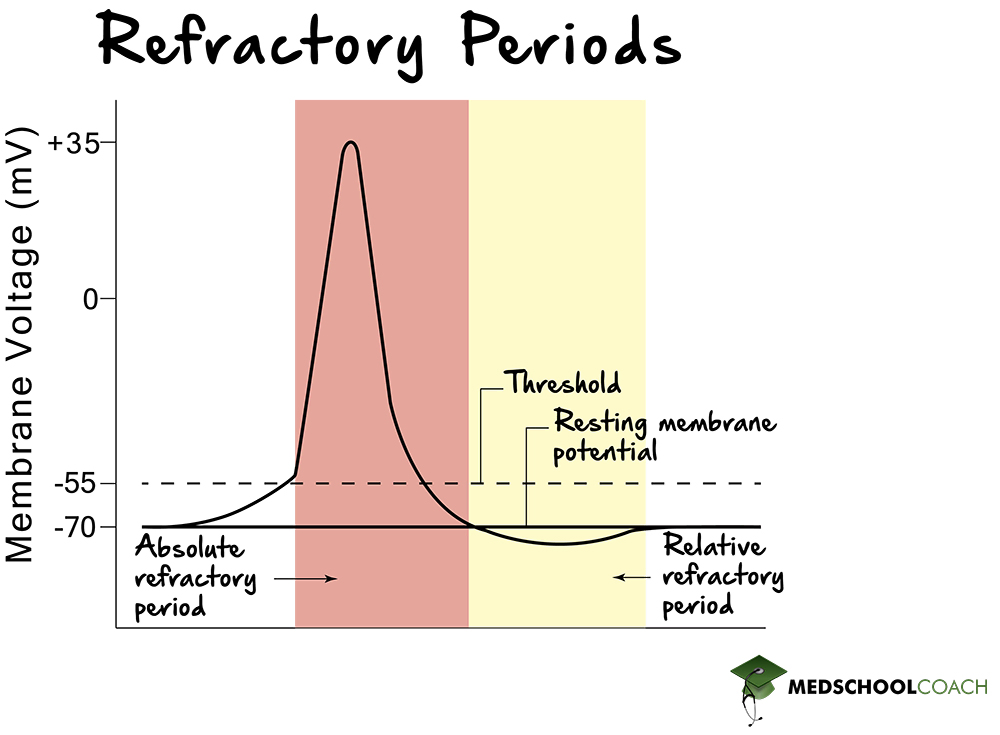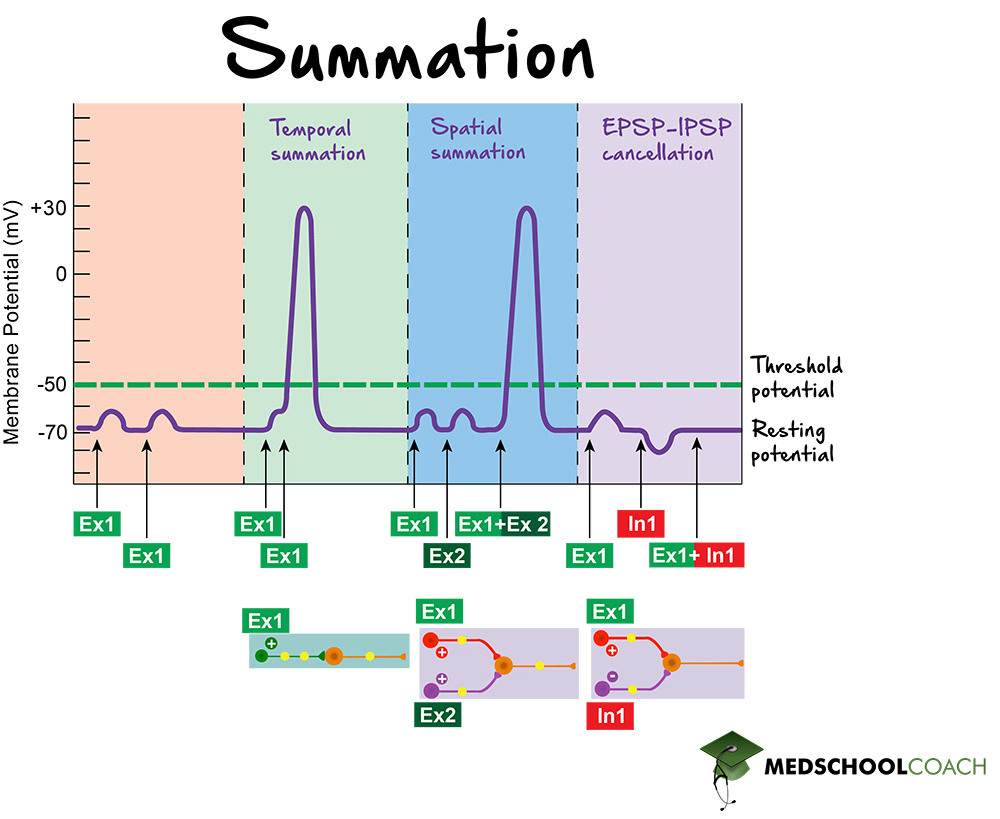Action Potentials, Refractory Period, and Summation
MCAT Biology
- Home
- »
- MCAT Masterclass
- »
- Biological and Biochemical Foundations of Living Systems
- »
- Biology
- »
- Action Potentials, Refractory Period, and Summation – MCAT Biology
Sample MCAT Question: Action Potentials
b) Spatial activation
c) Temporal activation
d) Temporal summation
D is correct. In order for a cell to reach the threshold potential and generate an action potential, signal summation is required.
There are two types of summation – temporal and spatial. During temporal summation, a single presynaptic neuron fires so quickly that before the previous signals can decay, another signal will fire. This creates an additive effect of the stimuli, in which signals are firing on top of each other, eventually creating a signal strong enough to overcome the threshold potential of the cell.
Get 1-on-1 MCAT Tutoring From a Specialist
With MCAT tutoring from MedSchoolCoach, we are committed to help you prepare, excel, and optimize your ideal score on the MCAT exam.
For each student we work with, we learn about their learning style, content knowledge, and goals. We match them with the most suitable tutor and conduct online sessions that make them feel as if they are in the classroom. Each session is recorded, plus with access to whiteboard notes. We focus on high-yield topics if you’re pressed for time. If you have more time or high-score goals, we meticulously cover the entire MCAT syllabus.
Action Potentials
Action potentials are signals that neurons send down their axons to downstream targets. At synapses, the presynaptic neuron that fires an action potential can release neurotransmitters that bind to receptors on the postsynaptic neuron. These receptors can open ion channels that allow positively charged molecules to flow into the postsynaptic neuron. This causes a small increase in the membrane potential of the postsynaptic neuron, and these small increases in membrane potential are known as excitatory postsynaptic potentials (EPSPs). By a similar process, presynaptic signals can also decrease the membrane potential (hence inhibiting an action potential). These decreases in membrane potential are known as an inhibitory postsynaptic potentials (IPSPs).
In order to fire an action potential, a neuron’s membrane potential must exceed a threshold value. For most neurons, this threshold value is about -55 mV. If the neuron receives enough excitatory input to reach threshold, then it fires an action potential. If the input isn’t enough to reach threshold, the neuron does not fire an action potential. The mechanism by which action potentials fire is therefore “”all or none.””
Phases of the Action Potential
The beginning of the action potential is represented in Figure 1 as phase 1. At this point, the cell is at rest and the membrane potential is approximately -70 mV. During phase 2, there is an excitatory stimulus. The more excitatory stimuli there are, the more EPSPs are generated and the more membrane potential will increase. If the threshold potential of -55 mV is not meet, nothing will happen. However, if the stimulus is strong enough to reach the threshold potential, the cell enters phase 3, depolarization. During this phase, voltage-gated sodium channels in the cell membrane open, positively charged sodium rushes down its concentration gradient into the cell, and membrane potential rapidly increases to a positive value.
Voltage-gated sodium channels are actually double-gated. The gate that opens and allows sodium into the cell during depolarization is the M gate. Once membrane potential has reached a certain positive value, another gate, the H gate, closes and blocks sodium from continuing to enter the cell. At the same time, the positive membrane potential causes voltage-gated potassium channels to open and positively charged potassium rushes down its concentration gradient out of the cell. Because the sodium and potassium channels are now closed and open respectively, the membrane potential begins to rapidly decrease. This is known as repolarization and is represented in Figure 1 as phase 4.
Once the membrane potential has repolarized to its normal resting value of -70 mV, the voltage-gated potassium channels begin to close. However, they close slowly, which means that for a brief period, membrane potential actually drops below its resting value of -70 mV. This period is known as hyperpolarization and is represented in Figure 1 as phase 5. Also, during hyperpolarization the voltage-gated sodium channels reset to their initial state: the H gates blocking the channels reopen and the M gates close.
After hyperpolarization and the closing of the voltage-gated potassium channels, the membrane potential to its resting value.

Refractory Period
The refractory period is the period of time during which it is either more difficult or impossible for the neuron to fire another action potential. As Figure 2 shows, there are two refractory periods: the absolute refractory period and the relative refractory period.

During the absolute refractory period, which occurs during depolarization and repolarization, it is impossible for the cell to generate an additional action potential. During this period, the M gates of the voltage-gated sodium channels are either already open (during depolarization), or else the H gates are closed rendering the sodium channels inactive (during repolarization). Once the H gates are closed, they do not reopen until membrane potential drops to a certain point. The fact that the H gates are closed and the sodium channels are inactivated makes it impossible for the cell to fire an action potential during the absolute refractory period.
During the relative refractory period, which occurs after the absolute refractory period during hyperpolarization, it is possible for the cell to fire another action potential; it just requires more excitatory stimulus than usual to do so. This is because at this time, the M and H gates of the voltage-gated sodium channels are closed and open respectively. These channels are thus capable of reopening if membrane potential reaches the threshold value. However, reaching threshold requires more excitatory stimulus than usual because the cell is hyperpolarized, meaning membrane potential is lower than its resting value.
Summation
Signals from presynaptic neurons don’t always result in action potentials in the postsynaptic neuron. Recall that some of these signals may be inhibitory, i.e. they may result in IPSPs that decrease the membrane potential. Further, even an excitatory signal may not result in an action potential if its magnitude isn’t great enough. So, for an action potential to occur, something called summation is required. Summation can be thought of as the “”adding up”” of presynaptic signals.
There are two types of summation: temporal summation and spatial summation. Temporal summation occurs when a single presynatic neuron sends excitatory signals so quickly that the corresponding EPSPs in the postsynaptic neuron “”add together”” before each one can decay away. In this way, the membrane potential of the postsynaptic neuron reaches threshold, triggering an action potential. On the other hand, spatial summation occurs when multiple presynaptic neurons send excitatory signals simultaneously and the corresponding EPSPs in the postsynaptic neuron “”add together””, bringing the membrane potential to threshold and triggering an action potential. Both temporal and spatial summation is shown in Figure 3. You can also see how summation doesn’t always result in a greater membrane potential. When an EPSP and IPSP are released at the same time, this results in cancellation, which not increase or decrease the membrane potential.

Explore More MCAT Masterclass Chapters
Take a closer look at our entire MCAT Masterclass or explore our Biochemistry lessons below.

One-on-One Tutoring
Are you ready to take your MCAT performance to a whole new level? Work with our 99th-percentile MCAT tutors to boost your score by 12 points or more!
See if MCAT Tutoring can help me
Talk to our enrollment team about MCAT Tutoring

MCAT Go Audio Course
Engaging audio learning to take your MCAT learning on the go, any time, any where. You'll be on the way to a higher MCAT score no matter where you are. Listen to over 200+ lessons.

MCAT Practice Exams
Practice makes perfect! Our mock exams coupled with thorough explanations and in-depth analytics help students understand exactly where they stand.

MCAT Prep App
Access hundreds of MCAT videos to help you study and raise your exam score. Augment your learning with expert-created flashcards and a question banks.